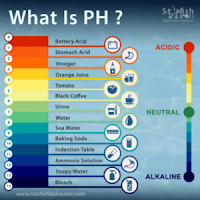What is pH?
 What is pH?
What is pH?
You may have heard the word “pH” used to describe drinking water quality, but do you know what it means?
.
pH is a measurement of electrically charged particles in a substance. It indicates how acidic or alkaline (basic) that substance is. The pH scale ranges from 0 to 14 :
.
pH is a measurement of electrically charged particles in a substance. It indicates how acidic or alkaline (basic) that substance is. The pH scale ranges from 0 to 14 :
• Acidic water has a pH lower than 7. The most acidic substances have a pH of 0. Battery acid falls into this category.
• Alkaline water has a pH of 8 or above. The most alkaline substances, such as lye, have a pH of 14.
• Pure water has a pH of 7 and is considered “neutral” because it has neither acidic nor basic qualities.
• Alkaline water has a pH of 8 or above. The most alkaline substances, such as lye, have a pH of 14.
• Pure water has a pH of 7 and is considered “neutral” because it has neither acidic nor basic qualities.
What pH is safe for drinking water?
The U.S. Environmental Protection Agency (EPA) is in charge of monitoring public drinking water quality across the United States.
pH isn’t a quality that falls under EPA regulation because it’s considered an aesthetic quality of water. However, the agency recommends that municipal drinking water suppliers keep their water supply at a pH of 6.5 to 8.5.
What does a changing or unsafe pH mean?
Freshwater pH varies across the world depending on weather patterns, human activity, and natural processes.
Water with a very low or high pH can be a sign of chemical or heavy metal pollution.
Water that doesn’t fall in the “safe” pH range of 6.5 to 8.5, particularly if it’s alkaline, isn’t necessarily unsafe. However, very alkaline water can have an unpleasant smell or taste, and it can also damage pipes and water-carrying appliances.
Water with a very low or high pH can be a sign of chemical or heavy metal pollution.
Water that doesn’t fall in the “safe” pH range of 6.5 to 8.5, particularly if it’s alkaline, isn’t necessarily unsafe. However, very alkaline water can have an unpleasant smell or taste, and it can also damage pipes and water-carrying appliances.
Acidic water with a pH of less than 6.5 is more likely to be contaminated with pollutants, making it unsafe to drink. It can also corrode (dissolve) metal pipes.
( source : healthline.com )
( source : healthline.com )
The ideal pH level of drinking water should be between 6 – 8.5.



Komentar
Posting Komentar